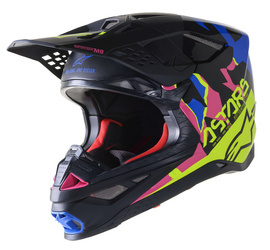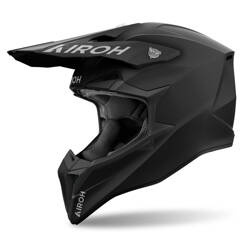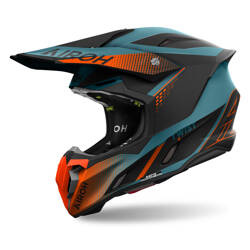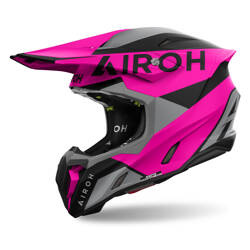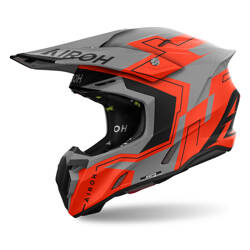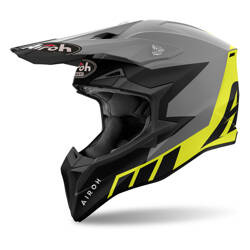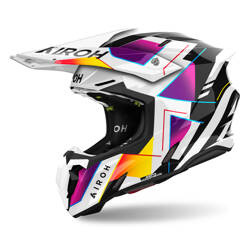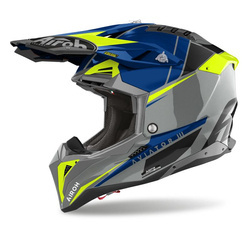Motocross Helmets
( number of products: 148 )From bums on forest trails to motocross sweepers, anyone who likes to get dirty on two wheels needs a good cross helmet to protect their mac. Enduro helmets are specifically designed for adequate protection in the most demanding offroad riding conditions.
Is it finally a cross or enduro helmet? If you've been interested in the subject for a while and browse the Internet in search of your dream helmet, you've probably noticed that one time some people write cross helmet, another time you find guides regarding enduro helmets. And here the question probably arises: what are the differences between a cross helmet and an enduro helmet? In simplistic terms, we can confidently answer that there is no significant difference. Yes, there are quite a few details and nuances that make some helmets more likely to be chosen by Mx riders, and others are lovingly used in hard enduro, but about that later.
.The cross helmet is most distinguished by its massive visor its primary purpose is to protect your eyes from anything that shoots out at high speed from under the wheel of your buddy's motorcycle, which is riding in front. The visor also provides considerable relief when riding in strong sunlight.
The characteristic extended and expanded jaw of cross helmets is designed to provide your chin with maximum safety even during the roughest soil. Thanks to this enduro helmet design, additional space appears in the chin and mouth area, which positively affects ventilation and facilitates breathing even in the greatest heat.
It is easy to notice that real cross helmets are devoid of a windshield. The explanation is very simple. When riding in the wilderness, all the dust that floats in the air settles on the windshield, not only on the outside. Due to its peculiar design, dust and debris can also easily enter the interior of the helmet and get into your eyes which is unacceptable for safety and comfort reasons.
Instead of a windshield, cross helmets are matched with cross goggles, which fit well on the face and 100 percent protect the rider's eyes from dirt. The use of goggles has forced the introduction of another important modification in cross helmets - a large eye opening.
The use of goggles has forced the introduction of another important modification in cross helmets - a large eye opening.
Buying a helmet for cross or enduro riding is not an easy task. The most common way is to model yourself after your favorite riders or simply choose the one you like the most, however, when you pay attention to the differences and the most important parameters, choosing the right cross helmet will be much easier, and the helmet itself will be better suited to your riding style.
How to choose a helmet for cross riding?
How to choose a cross helmet?
.First of all, your cross/enduro helmet should be the most important piece of your equipment. A cross/enduro helmet is the only thing between your head and the hard ground. That's why it's so important to get the right cross helmet for the shape of your head and your preferences.
First of all, how to know if a motorcycle cross helmet is properly sized?
.When choosing a helmet, you need to consider the shape of its shell and size. Remember that the sizes of cross/enduro helmets can vary from manufacturer to manufacturer. Always check not only the size, but also the head circumference that corresponds to a given size before buying. To properly size a helmet, measure the circumference of your head about 3 cm above your ears. Then, when measuring the helmet, pay attention to whether the helmet sits straight on your head, whether the goggle opening is appropriate and, most importantly, whether the helmet does not put pressure on your head at points. The cross/enduro helmet should fit snugly to your head, it can squeeze your cheeks tightly, butit should not painfully press you pointly inyour head. Then, holding your head stiffly and grabbing the jaw of the helmet, try to rotate the helmet to one side and the other. If the helmet rotates easily, then unfortunately it is too big for you. If you are afraid that the helmet wraps around you too tightly, you also need to remember that the padding in enduro and cross helmets will break down after a while. If you have any doubts about the size, call us and we will help you choose the best helmet for you.
When choosing a helmet, the issue of ventilation is also important. Most often, the more ventilation the better, the more intake and exhaust vents, the better for you. Numerous ventilation in a cross/enduro helmet helps to maintain a constant temperature, so you sweat less, which again affects the fact that less dust settles on you.
Helmet shell shape. One of the most important issues in helmet selection. Heads vary in shape, so not every enduro and cross helmet will fit every head. Your buddy may say that an Arai helmet is the most comfortable helmet in the world, meanwhile, as soon as you put it on your head, you may strongly wonder why he has such views at all. After all, according to you, it is one of the most uncomfortable cross/enduro helmets you have had on your head. That's why it's a good idea to try on several brands to see which fits you best, and then look among them for the one of your dreams.
How much should a cross/enduro helmet weigh?
For some, this is one of the most important aspects when choosing a helmet, while others, meanwhile, pay no attention at all to how much enduro and cross helmets weigh. Here we would like to point out that weight is of great importance when riding cross/enduro. Very heavy helmets can affect not only riding comfort, but also our position on the motorcycle. They often cause bending on the motorcycle, which again results in neck pain at the end of the ride. It may sound strange, but very heavy helmets also tend to have worse ventilation, so you will start to sweat more, and all the fun of riding a cross/enduro motorcycle will be significantly lost in your eyes. Many motocross trainers point out that the limiting weight is about 1600 grams, above this weight you usually already start to feel the weight of the helmet on your head significantly. This does not at all mean that you should give up your dream helmet, which is 1650 grams, but 1900 grams is definitely too much.
What features and certifications do enduro and cross safety helmets have?
.You probably know that there are several organizations around the world that certify helmets and determine their safety standards. The two main certifications for cross helmets are DOT and ECE.
The DOT certification is the FMVSS 218 federal standard in the United States. Any helmet approved for marketing must meet all of its guidelines.
In Europe, we have ECE and it is one of the most popular certifications in the world. More than 50 countries around the world adhere to the ECE standard.
What is MIPS technology and is it useful?
MIPS is a multi-directional impact protection system, a relatively young technology used in FOX helmets. MIPS technology is based on reducing rotational movements by absorbing and redirecting the energy and rotational forces that are transmitted to the brain during angular impacts. MIPS technology was developed in Sweden and is now being implemented in many helmets around the world. You won't find a label on Airoh corss helmets about the use of MIPS technology, but the best Airoh helmets can also be equipped with their own rotational impact protection system. You will certainly find information about this in the description of the helmet.
.What else should you look for when choosing a cross/enduro helmet?
For sure, a big advantage will be the removable helmet liner, so you can always take it out after an intense ride and throw it in the washing machine.
Another advantage will be a detachable magnetic visor or visor with breakaway screws. Fox helmets and airoh cross helmets in some models have such visors. Thanks to them, you will be much safer in the field, because in case of snagging on, for example, a branch, the visor will detach, but will not pull you off the motorcycle. When snagged on a branch, most often there is a quick twisting motion, and this, in the worst case, can lead to injury to the cervical spine. So the rippable visor, combined with the flexible shell, helps cushion the impact even during severe accidents.
.When to replace a cross/enduro helmet?
.We replace a helmet first and foremost after a major impact or crash. Unquestionably when we hit so hard that the shell breaks. Most cross/enduro helmet testers indicate that a helmet should be replaced every five years or so. However, if your padding has already compacted so much that the helmet is flying around on your head, that is definitely the time to replace it. Depending on how much you ride and how heavily you use the helmet, this period should decrease. If you ride a lot, your helmet will probably score a few falls on the motocross track or in the woods during the year, falls on the back of a bus or during a water break also count. It's then worth considering whether it would be safer to replace your helmet once a year.
.Now you know how to choose a cross helmet.
.Why should you not paint a cross/enduro helmet yourself?
We strongly advise against painting a helmet yourself. It may seem strange to you, but an inappropriate paint or spray can affect the structural composition of the shell of a cross/enduro helmet, and thus your safety. Therefore, if you already want to change the paint job on your helmet, get it done by a professional company, and preferably cover it non-invasively with stickers.
Comparison of cross helmets in the safest and best helmets section:
- Fox Racing V3 helmet. .
Fox has more than 40 years of experience in manufacturing cross/enduro helmets and motocross and enduro apparel. The Fox V3 helmet is the highest quality helmet in the mid-price range. The brand has even achieved a perfect balance between the quality of the helmet's performance and price value. It uses the aforementioned MIPS technology, a magnetic visor detachment system. In addition, since 2022 Fox helmets have been equipped with an improved MVRS system, so that the visor will not fall off when you least expect it. In addition, a novelty is the use of the developed, state-of-the-art Varizorb liner, which is designed to distribute the energy absorbed from the impact even better, so that it is not concentrated in one point. Cross/enduro helmets by Fox model V3 are characterized by ventilation refined in every detail, which has been protected by an additional mesh liner that prevents dirt and dust from entering the ventilation channels, which could result in their clogging. These helmets weigh approximately 1220-1400 grams, depending on size.
2. Airoh Aviator 3.0 cross helmet
One of the fastest growing brands. As a result, Airoh Aviator cross helmets have been greatly improved. You'll find it in two versions one labeled Airoh Aviator Primal, made of 3k carbon fiber and weighing just 1270 grams, and the other made of standard HPC carbon fiber and weighing a little more at 1330 grams. These helmets are equipped with the MIPS system (AMS2+). The AMS 2+ system consists of two inner shells that have been surrounded by a single layer of silicone. This silicone layer is a patented way to transfer multidirectional forces in the event of a head impact. Airoh has offered us enduro and cross helmets that feature a very good ventilation system. The Airoh Aviator cross helmet large ventilation holes under the chin and on the forehead, which effectively cools down while riding. Of course, it uses a removable liner and a large opening for goggles.
3. Alpinestars Supertech M10 helmet
In the comparison of corss helmets could not miss the Aplinestars brand. The Supertech M10 is the best enduro and cross helmet in the Alpinestars brand's range. It had its premiere in 2018 and is still very popular. It is made of carbon composite and is available in 4 sizes. It has 16 air intakes and 5 air outlets which puts it significantly ahead in terms of ventilation. The downside of this helmet is the lack of adjustability of the visor, but it uses breakaway screws. The helmet also uses MIPS technology. One of the lightest helmets, it weighs only 1240 grams.
4. Leatt Moto 9.5 cross helmet made of carbon fiber
Today one of the lightest carbon fiber helmets (1195 grams) available on the market. The Leatt Moto 9.5 helmet features an aggressive design, a peel-off visor and an emergency cheek pad extraction system. The shell is available in 3 sizes, and on top of that the Leatt Moto 9.5 helmet offers, up to six sizes of inner liners, which allow you to perfectly adjust the helmet to the shape and size of your head. In addition, the antibacterial removable liner allows you to maintain the highest comfort. The helmet is equipped with a 360-degree system that effectively absorbs and distributes impact forces.
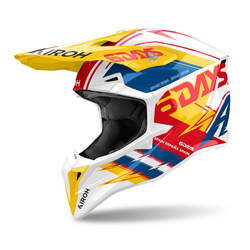
Kask Airoh Wraaap Reloaded biały,czarny,czerwony / połysk
